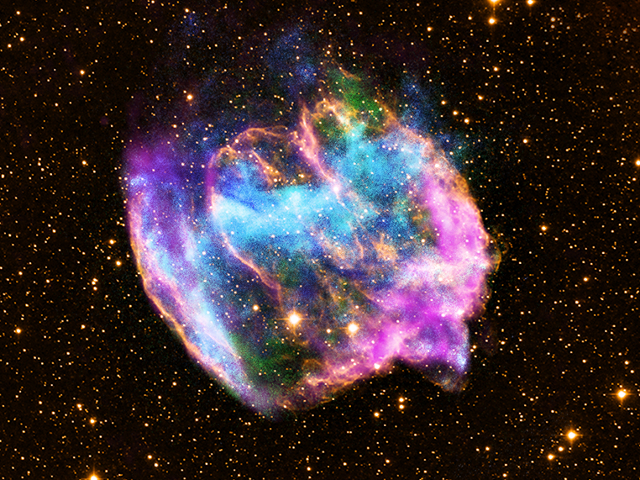
While stars like our Sun go gently into that good night, stars more than 25 times more massive explode in violent supernovae. Since stars that big are rare, their explosions are too, so astronomers typically have to do forensic work on supernova remnants in our galaxy. One particular remnant is one the brightest X- and gamma-ray sources around, marking it as a relatively recent explosion. By studying the remnant, astronomers have determined it likely harbors the youngest black hole in the Milky Way, and the original explosion may have been extremely energetic.
Laura A. Lopez, Enrico Ramirez-Ruiz, Daniel Castro, and Sarah Pearson used long-exposure X-ray observations to study the remnant. They found distinct signs of a supernova with strong jets shooting from the poles. The astronomers failed to find any sign of a neutron star, meaning the supernova must have left a black hole instead. And the emissions suggest it's only 1,000 years of age, which would make the black hole the youngest known in our galaxy.
Over their lifetimes, stars fuse light atoms into slightly heavier ones, but fusing most of the elements in the periodic table requires the intense energies of a supernova. By mapping certain of these elements—iron in particular—in a supernova remnant, astronomers can recreate the conditions under which the star died.
Most supernovae are roughly spherical: the star that made them explodes more or less equally in all directions at once. This shows up in the signature of the elements produced in the explosion: if the cloud is mostly spherical, then the explosion was symmetrical. However, if the remnant is non-spherical, there are a number of potential explanations.
However, at least one significant type of supernova is inherently asymmetric. Known as a bipolar or jet-driven supernova, this type explodes energetically, with matter channeled preferentially into two jets aligned with the poles of the dying star. While stars more than 8 times the Sun's mass die in supernovae, only very massive stars—greater than 25 times the mass of the Sun—can produce bipolar supernovae, according to theory. When Earth lies in the direction of one of the jets, the supernova appears much brighter and includes many gamma rays, so it is known as a gamma ray burst.
(Gamma ray bursts have been known since the 1960s when they were spotted by spy satellites looking for illicit testing of nuclear weapons, but until fairly recently their origins were mysterious.)
The signature of such a supernova is an elongated structure running through the heart of the remnant, which can be seen via X-ray emissions from iron atoms. Another giveaway is the balance of chemical elements: in bipolar supernovas, silicon and sulfur are noticeably less abundant than they are in spherical explosions. So, to spot a bipolar supernova, astronomers need to look for several types of evidence, all of which can be gathered using detailed X-ray observations.
Supernova remnant W49B is one of the brightest in the galaxy, in terms of its X-ray and gamma ray emission. Previous observations found that the iron atoms were nearly absent from one side of the supernova, while other elements were more regularly distributed.
The authors of the present study observed W49B with the Chandra X-ray Observatory for over 60 hours, allowing a deep examination of the structure and composition of the remnant. They found the clear sign of a lane of iron atoms running through the remnant, and relative abundances of other elements consistent with a bipolar supernova—the first of its kind ever observed in the Milky Way.
Additionally, they looked for X-ray emissions from a neutron star, the dense collapsed core of a massive star produced by most supernovas. Since W49B is only about 1,000 years old, a neutron star at its heart would be very bright, but the researchers found nothing. Since there are only two possible outcomes from a supernova, the researchers concluded the other possibility must be true: W49B has a black hole at its center. If that's the case, the black hole is the youngest known in our galaxy.
The remnant is about 26,000 light-years away, so when I say it is 1,000 years old, I mean it actually happened 27,000 years ago, and its light didn't reach us immediately. A supernova so distant wouldn't have been as noticeable as, say, the Crab Nebula supernova seen in 1054 CE, which was briefly visible in daylight. However, if our ancestors had possessed gamma ray telescopes, they would have seen the only known gamma ray burst in the Milky Way's history, and had metaphorical front-row seats to one of the most violent explosions in the Universe.
The arXiv. Abstract number: 1301.0618 (About the arXiv). To be published in Astrophysical Journal.
reader comments
28